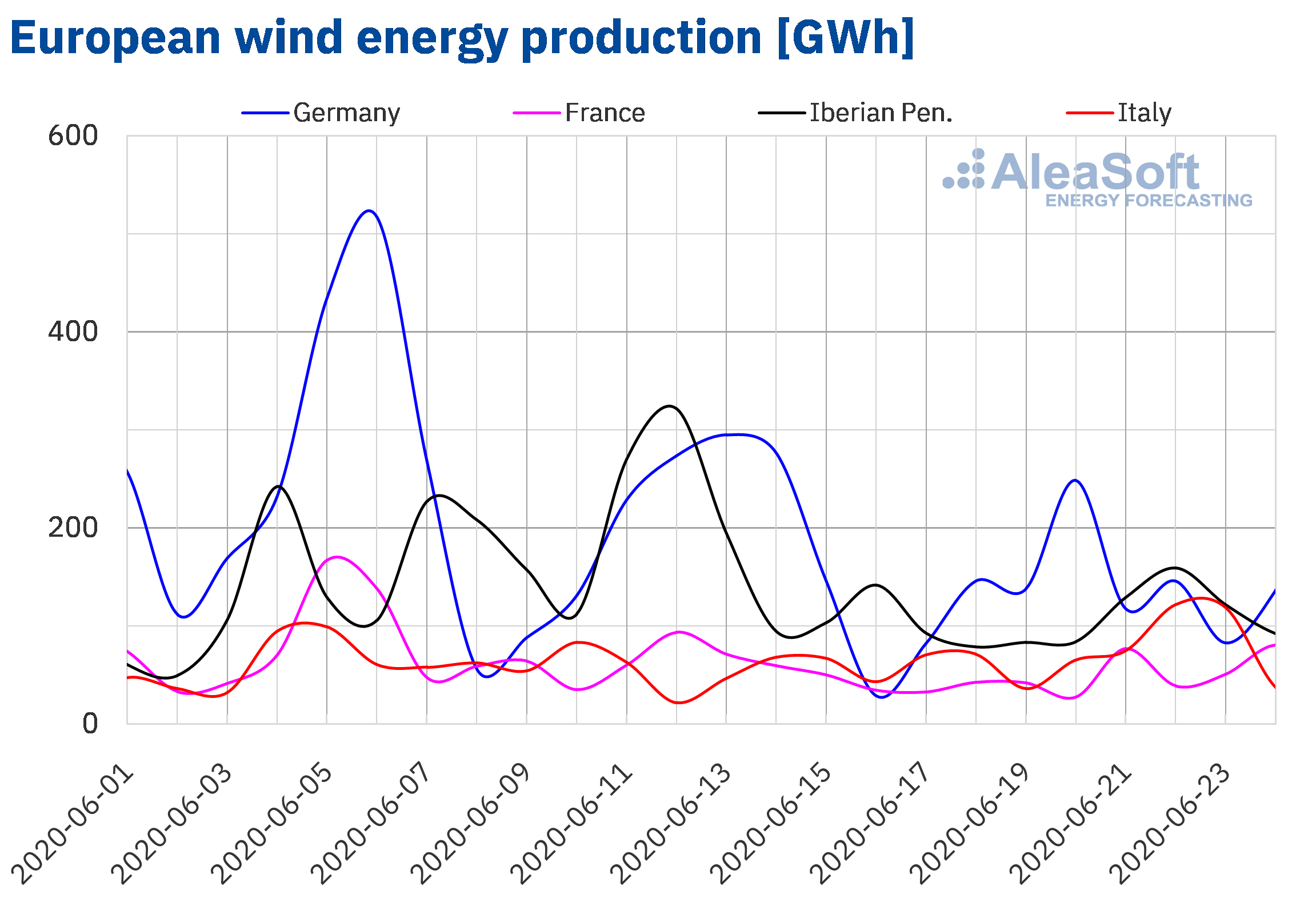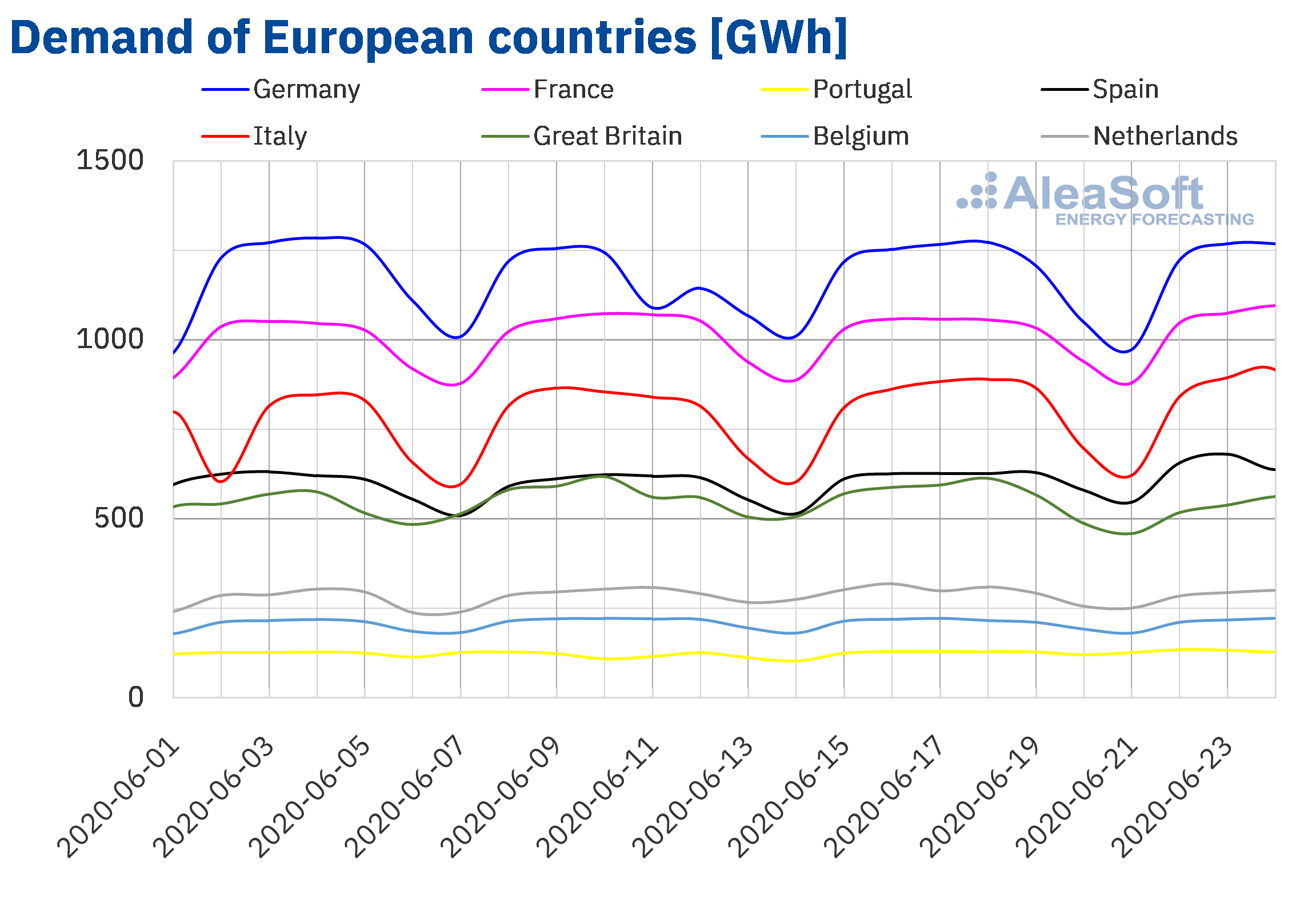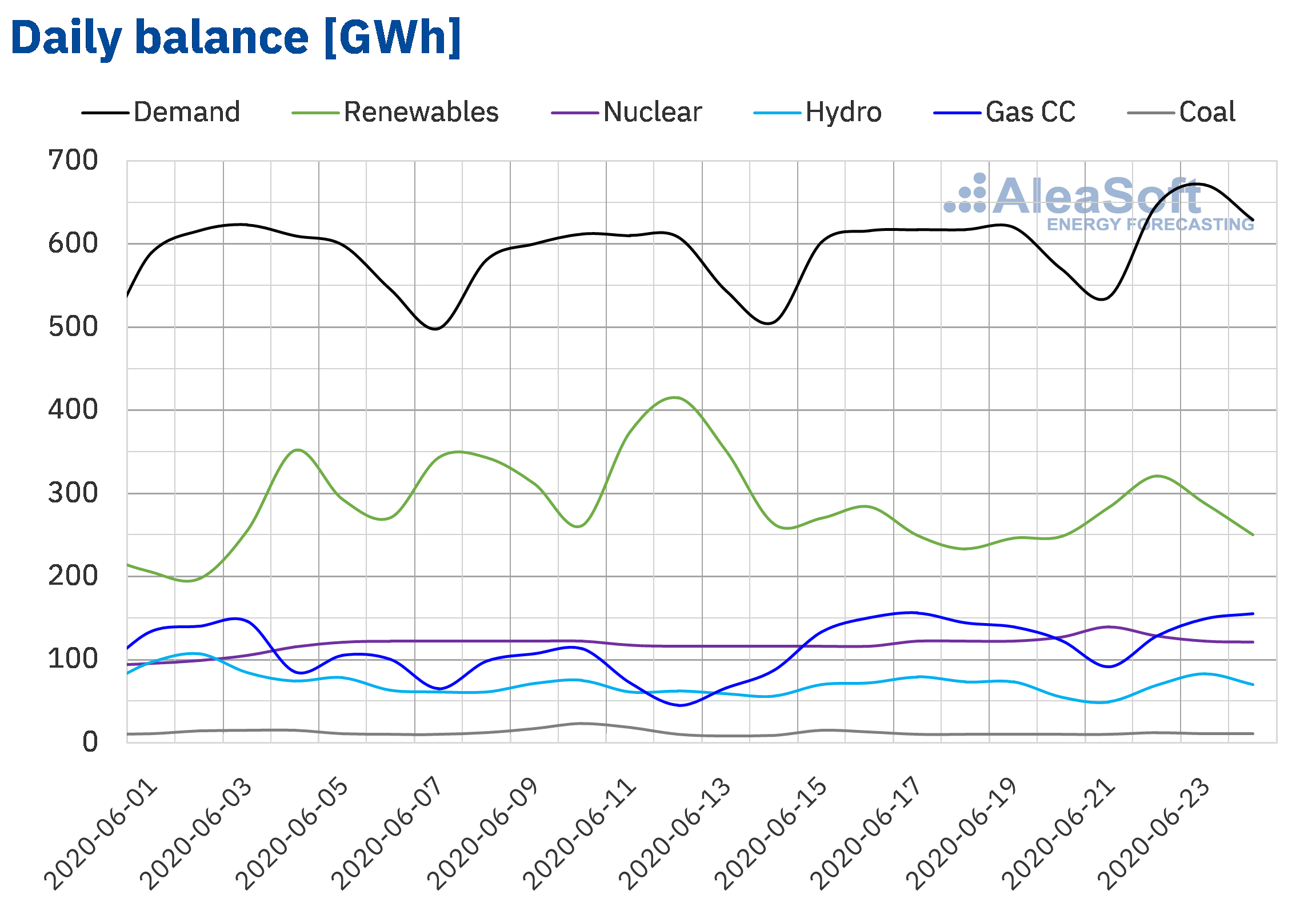AleaSoft, June 25, 2020. The European electricity markets prices remain above €30/MWh, and in some markets such as MIBEL and IPEX they approached €40/MWh. This behaviour is mainly due to the increase in electricity demand. The fact that the gas prices continued to recover and the CO2 prices continued to rise are other factors that also favoured prices to continue above this level even though the wind and solar energy production increased in most of the markets.
Photovoltaic and solar thermal energy production and wind energy production
The production with renewable energies in Europe registered increases in most markets from June 22 to 24 compared to the average values of the week of June 15. In the case of the solar energy production, there were increases in Germany, France, Italy and Spain, of 50%, 31%, 7.0% and 0.6% respectively. On the contrary, in the market of Portugal a fall of 4.1% was registered.
During the first 24 days of this month, the solar energy production was higher in most markets compared to the same period of June 2019, except in the German market, where it fell 10%. The main increases were in Spain and Portugal with variations of 47% and 18% respectively.
The forecasting carried out at AleaSoft indicates that at the end of this week the solar energy production will be higher than in the third week of this month in Germany and Italy, while in Spain it will end up being lower.
 Source: Prepared by AleaSoft using data from ENTSO-E, RTE, REN, REE and TERNA.
Source: Prepared by AleaSoft using data from ENTSO-E, RTE, REN, REE and TERNA.
 Source: Prepared by AleaSoft using data from ENTSO-E, RTE, REN, REE and TERNA.
Source: Prepared by AleaSoft using data from ENTSO-E, RTE, REN, REE and TERNA.
In the case of the wind energy production, the behaviour was bullish from Monday to Wednesday of the week of June 22 in most of the analysed markets. The most notable increases were those of Spain and Italy, which registered 40% and 51% respectively. In the case of the wind energy generation in Portugal, it had the same behaviour as the solar energy production, falling 25%.
Most markets registered increases during the days from June 1 to 24, 2020, in year‑on‑year terms. In this period, it should be noted that in Italy there was a rebound of 121%, while in France and Spain the increases were moderate, of 1.9% and 5.5%. The exceptions were Germany and Portugal with decreases of 13% and 8.3% respectively.
The AleaSoft’s wind energy production forecasting results indicate that there will be a recovery towards the end of the week in the German market. In the rest of the markets, except in Portugal and Italy, the weekly total is expected to be higher than that of the week of June 15.
 Source: Prepared by AleaSoft using data from ENTSO-E, RTE, REN, REE and TERNA.
Source: Prepared by AleaSoft using data from ENTSO-E, RTE, REN, REE and TERNA.
Electricity demand
During the first three days of the week of June 22, the electricity demand increased in a large part of the analysed markets with respect to the same days of the previous week. The increases registered during this period were between 0.6% of the German market and 6.0% of the Spanish market. The return to the new normality in some European countries and the easing of the restrictions to stop the spread of COVID‑19 allowed the demand to increase during these days, in addition to the fact that the average temperatures were higher than those registered during the first three days of the week of June 15 in most of Europe. The country with the highest increase in temperatures was Portugal, where they were 4.6 °C higher and the demand rose 3.3%. On the other hand, the exceptions in the behaviour of the demand were Great Britain, the Netherlands and Belgium, where they fell by 7.7%, 4.2% and 0.8% respectively. In the case of the Netherlands the temperatures were lower than the same days of last week by 0.1 °C, while in Great Britain and Belgium they were higher by 1.0 °C and 0.1 °C.
The electricity markets observatories, available on the AleaSoft website, allow a detailed analysis of the evolution of the electricity demand and other market variables to be made.
The AleaSoft‘s electricity demand forecasting indicates that at the end of the week the total demand will be higher than in the previous week in most markets, while in Great Britain and the Netherlands it will be lower.
 Source: Prepared by AleaSoft using data from ENTSO-E, RTE, REN, REE, TERNA, National Grid and ELIA.
Source: Prepared by AleaSoft using data from ENTSO-E, RTE, REN, REE, TERNA, National Grid and ELIA.
Mainland Spain, photovoltaic and solar thermal energy production and wind energy production
The electricity demand increased by 6.0% in Mainland Spain in the first three days of this week, of June 22, compared to the same period of the third week of the same month. This increase in demand is fundamentally supported by the advance to the new normality of the entire Spanish territory, which since last Sunday, June 21, ended the confinement in the regions that were still in phase 2 and phase 3 of the state of alarm, in addition to the increase in temperatures. The AleaSoft’s analysis indicates that, at the end of the week, the demand will continue to be above that of the week of June 15.
At the beginning of the week of June 22 in Mainland Spain, there were increases in both solar energy production, which includes the photovoltaic and the solar thermal technologies, and wind energy production. The average values of the solar energy production for the first three days of the week increased by 0.6% compared to the average for the week of June 15. From the year‑on‑year point of view, there was an increase of 47% during the days from June 1 to 24, 2020. At AleaSoft, it is expected that in the week of June 22, the solar energy production will finish below the previous week’s total.
Regarding the wind energy production, the week started with a recovery of 40% compared to the average of the third week of the month. While, in year‑on‑year terms, compared to the first 24 days of June 2019, the increase was 5.5%. The AleaSoft‘s wind energy production forecasting indicates that this week the production will recover from last week’s total.
With the incorporation of the Trillo and Almaraz I plants on Tuesday, June 23, the nuclear energy production recovered by 0.2% in the first three days of the week of June 22, compared to the average of the previous week. That same day 23, the Ascó II nuclear power plant went into a cold shutdown, when a failure was detected in the motor of an extraction pump. It is expected to start operating again on Saturday, June 27.
On Wednesday, June 23, the Plenary of the Nuclear Safety Council (CSN) supported the extension of the operating license of the Vandellós II plant until 2030. The current operating permit for this plant, which has 1 GW of capacity, was granted in the summer of 2010 and expires on July 26. The Ministry for the Ecological Transition and Demographic Challenge will be the one who makes the final decision on the extension.
 Sources: Prepared by AleaSoft using data from REE.
Sources: Prepared by AleaSoft using data from REE.
According to data from the latest Hydrological Bulletin of the Ministry for the Ecological Transition and the Demographic Challenge, the level of the hydroelectric reserves is currently at 15 639 GWh, which represents 68% of the available capacity. The variation with respect to the previous bulletin was 1.2%.
European electricity markets
The first four days of the week of June 22 there were decreases in the prices of most of the analysed electricity markets with respect to those of the same days of the third week of June. However, in the EPEX SPOT market of France, the MIBEL market of Spain and Portugal and the IPEX market of Italy, there were increases of 2.7%, 7.0% and 9.0% respectively. On the other hand, the greatest fall in prices, of 12%, was that of the Nord Pool market of the Nordic countries. While the smallest decrease, of 0.9%, occurred in the N2EX market of Great Britain. In the rest of the markets, the price declines were between 1.2% of the EPEX SPOT market of Belgium and 2.4% of the EPEX SPOT market of the Netherlands.
However, despite the decreases, the average price for the first four days of this week was above €30/MWh in almost all of the analysed electricity markets. The Nord Pool market was the exception with an average of €4.24/MWh, the lowest so far this week. The rest of the markets had average prices between €32.54/MWh of the EPEX SPOT market of Belgium and €35.43/MWh of the MIBEL market of Spain and Portugal.
On the other hand, in the first four days of the week, the daily prices remained below €40/MWh in the analysed European electricity markets, the highest being those of June 25 in the Iberian and Italian markets, of €39.43/MWh and €38.35/MWh respectively.
 Source: Prepared by AleaSoft using data from OMIE, EPEX SPOT, N2EX, IPEX and Nord Pool.
Source: Prepared by AleaSoft using data from OMIE, EPEX SPOT, N2EX, IPEX and Nord Pool.
The increase in renewable energy production favoured the price declines in the first days of the fourth week of June. But the increase in temperatures and demand favoured prices to stay above €30/MWh and to increase in the countries with the highest average temperatures.
The AleaSoft’s price forecasting indicates that at the end of the week the weekly average price will be higher than that of the week of June 15 in most of the analysed markets, with the exception of the markets of Germany, Great Britain and the Netherlands. This behaviour will continue during the first days of the next week of June 29, where the decline in renewable energy production in some markets may favour this trend.
Iberian market
The average price of the first four days of the week of June 22 increased by 7.0% compared to that of the same period of the previous week in the MIBEL market of Spain and Portugal. This was the second largest price rise in the European electricity markets, after the 9.0% increase of the IPEX market of Italy.
Despite the increase in wind and solar energy production in the Iberian Peninsula, the increase in demand in Spain and Portugal allowed this rise in prices during the first days of the week.
The average price from June 22 to 25 was €35.43/MWh in both Spain and Portugal. In this period, the daily average prices remained above €30/MWh with an upward trend. The highest daily price in this period was that of Thursday, June 25, of €39.43/MWh. This is the highest price in this market since the end of February.
The AleaSoft‘s price forecasting indicates that the average price at the end of the week will be higher than that of the third week of June. Similarly, the price for the first days of the next week of June 29 is expected to be higher than the price for the period from June 22 to 25. The recovery in demand and the decrease in solar energy production in Spain will favour this behaviour.
Electricity futures
So far this week, most of the futures markets analysed at AleaSoft continued the upward trend in the prices of the product of the next quarter that they presented since last week. The exceptions continued to be the ICE and NASDAQ markets of the Nordic countries, which with respect to Friday, June 19, settled the session of Wednesday, June 24, with drops of 3.0% and 3.2%, respectively. It was in the Iberian markets where there was the greatest variation in the prices for this product, 6.0% in the EEX market of Spain and 5.2% in the OMIP market of both Spain and Portugal.
In the case of futures for the 2021 calendar year, the rise was widespread in all the markets analysed at AleaSoft. In the case of this product, the markets of the Nordic countries were those with the highest price increases, of 5.8% in the ICE market and 5.5% in the NASDAQ market. Great Britain, both in the EEX market and in the ICE market, was the region for which the smallest variation was registered for this product, with an increase of 1.2% in both markets. In the rest of the markets the increases were between 1.3% and 2.9%.

Brent, fuels and CO2
The Brent oil futures prices for the month of August 2020 in the ICE market began this week with the upward trend of the previous week, registering a settlement price of $43.08/bbl on Monday, June 22. This price was 8.5% higher than that of Monday of the third week of this month and the highest since the beginning of March. But on Tuesday this trend changed and on Wednesday the settlement price, of $40.31/bbl, was already 1.0% lower than that of Wednesday, June 17.
Despite the fact that the OPEC+ production cuts and the start of the recovery in demand allowed the prices to rise, the new coronavirus outbreaks raised the concerns about the recovery in demand, which was reflected in the registered price declines. In addition, data on the increase in United States crude reserves was published on Wednesday, which also had a downward influence on the prices.
In the coming days, if contagions continue to increase, the governments could take measures to stop the spread of COVID‑19, which would imply a setback in the recovery of the demand and the prices.
Regarding the TTF gas futures in the ICE market for the month of July 2020, they started the week with a settlement price of €5.49/MWh, which was €0.12/MWh lower than that of Friday, June 19. But on Tuesday, June 23, there was an increase of 6.1% and a settlement price of €5.83/MWh was registered, 11% higher than that of Tuesday, June 16, and the highest since the first half of May. On June 24, the prices fell again, reaching a settlement price of €5.66/MWh, which is still 8.7% higher than that of Wednesday of the third week of the month.
Regarding the prices of TTF gas in the spot market, the first four days of this week of June 22, had an overall upward trend, despite registering a slight decline on Tuesday, June 23. The maximum index price so far this week, of €5.65/MWh, was reached on Thursday, June 25, and was the highest since mid‑May.
As for the API 2 coal futures prices in the ICE market for the month of July 2020, the first days of the week of June 22, they continued the upward trend that started the previous week. On Wednesday, June 24, they reached a settlement price of $48.10/t, 7.2% higher than that of the same day of the week of June 15 and the highest since the first half of April.
On the other hand, the CO2 emission rights futures prices in the EEX market for the reference contract of December 2020 started this week of June 22 with increases until reaching a settlement price of €25.41/t on Tuesday, June 23. This price was 12% higher than that of the same day of the third week of June and the highest since the penultimate week of February. On Wednesday, June 24, the settlement price was €0.01/t lower than the previous day.
 Source: Prepared by AleaSoft using data from ICE and EEX.
Source: Prepared by AleaSoft using data from ICE and EEX.
AleaSoft analysis on the effects on the electricity markets due to the coronavirus crisis
The AleaSoft’s webinar “Influence of coronavirus on electricity demand and the European electricity markets (III)” was held with great success on June 25. The speakers Oriol Saltó, Manager of Data Analysis and Modelling, at AleaSoft, Pablo Otín, CEO and co‑founder, at Powertis and Miguel Ángel Amores, Manager of Renewable Energy, at Triodos Bank, analysed how the energy markets and the financing of renewable energy projects behaved during the COVID‑19 crisis, focusing on the prospects for the coming months, taking into account the uncertainty generated by the pessimistic growth forecasting of the economy and the possibility of new outbreaks of the epidemic.
Considering the difficulty of predicting the medium and long‑term consequences of the pandemic on the economy and the energy markets, on September 17 at AleaSoft a new webinar “Energy markets in the recovery of the economic crisis” will be imparted, in which the evolution of the electricity, fuel and CO2 markets since the de‑escalation of the confinement measures against the epidemic began, and which are the prospects for recovery will be analysed. The impact that this crisis had on the development and the financing of new renewable energy projects and which the consequences may be in the medium and long term will also be analysed.
Another way to monitor the evolution of the energy markets with daily updated data is the AleaSoft’s observatories.
Source: AleaSoft Energy Forecasting.
